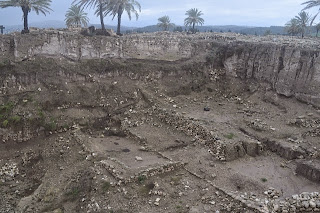So, what do you picture when you think of Israel? Arid deserts? Dry heat? Blazing sun? Yeah, me too. So what was it like today? SO WINDY AND COLD IT EVEN HAILED.
Ahem. Anyway…
First stop of the day was Caesarea, the great seaport of old. We braved the gale-force winds to explore its remains. Standing on the upper tiers of the Roman theater, we could see the Mediterranean Sea clawing ferociously at the beach.
The history of the place is humbling, to say the least. From our vantage point, we could just glimpse the hippodrome: the huge dirt track used for horse races, games, and eventually, gladiatorial combat and the slaughter of Christians. Caesarea was also the place where Paul stood before Agrippa to testify to his faith, asking to be tried before Caesar himself in the heart of Rome. It’s the same city where Pontius Pilate ruled, and would leave in the spring to travel to Jerusalem. The city has crumbled, been rebuilt, collapsed, been restored, suffered destruction at the hands of conquerors, and yet its remnants stand all these thousands of years later, against the battering of the sea and wind.
A mile down the road, we jumped out of the bus for a brief stop at an aqueduct along the coast. These structures were works of brilliance and fine engineering…this aqueduct was built in the time of Hadrian. To stand under its arches is to feel a little bit of the epic scope - that is if you could brace yourself against the wild wind.
Next up was Mt. Carmel, where Elijah called out the priests of Baal. Driving up, it started to feel “real” for the first time. The hillsides are lush green, thick with trees and scatterings of rocks. There are even the occasional goats. They just look like biblical hills. At the top of Mt. Carmel is a sanctuary/monastery built to honor Elijah’s actions in striking down Baal’s priests.
It’s small, peaceful, and has an astonishing view of the Valley of Jezreel that sprawls below it. We had just reached the top when we got our very own plague: HAIL. Coming fast and hard, pinging ears and stinging faces. It was a mad dash back to the bus once more…
Lunch was falafel. At a Druze falafel place. Then we all got terrible cups of tea just to warm our hands, and huddled in front of the lone space heater.
By the time we got back on the road, God had mercifully hit pause on the rain. On our route, we passed an old tomb on the roadside. Though less spectacular than many of our other sights today, this was especially moving. It’s the kind of tomb Jesus was buried in, complete with the massive rolling stone door. We couldn’t get out to see it up close, but even the fact that it’s still preserved on some random hillside along an otherwise unremarkable road is special.
To Armageddon we went. Literally. Har – mountain. Megiddo – the city. Megiddo is a city on a hill, the crux of the most important trade route of the time. Back in the day, there were two great powers: that of Egypt and that of Mesopotamia. Megiddo ruled over the valley route that connected these two. It was a vital stronghold. So vital that it was conquered and rebuilt dozens of times. It’s a treasure trove of archaeology, and is always under some kind of excavation. 25 “layers of city” can be seen on that hilltop. We walked through the huge chambered gates…strolled through the stables…looked down on the massive sacrificial altar...scouted the whole Valley of Jezreel. We looked out to where Gideon chose his 300 warriors by the riverbank. We glimpsed Nazareth across the way, shining in the only sliver of sunlight we saw all day.
The end of our day had us reaching the city of Tiberias, in Galilee. This was Jesus’ turf. His zone. His stomping grounds. We hadn’t been inside our hotel more than ten minutes when the skies opened up with vivid lightning and cracks of thunder amidst the howling wind. The Sea of Galilee is just a short way from our hotel, and it’s not hard to imagine that this was this kind of storm that arose suddenly two thousand years ago in this very place, terrifying the disciples aboard their boat. The hills that rise up around us? They look like they could very well accommodate five thousand hungry people…























No comments:
Post a Comment